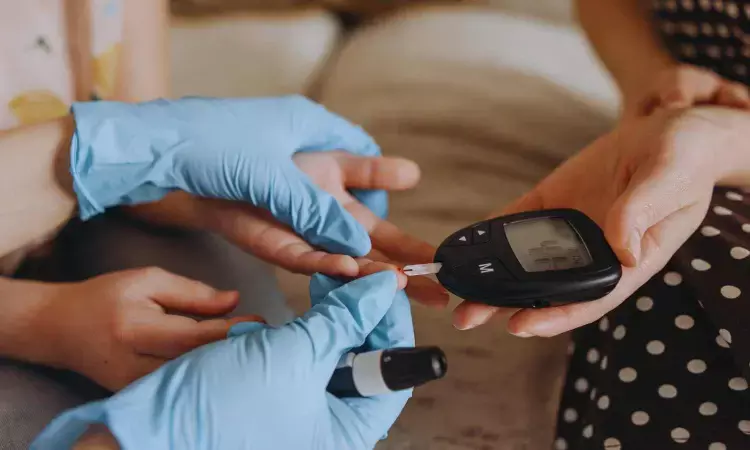- Home
- Medical news & Guidelines
- Anesthesiology
- Cardiology and CTVS
- Critical Care
- Dentistry
- Dermatology
- Diabetes and Endocrinology
- ENT
- Gastroenterology
- Medicine
- Nephrology
- Neurology
- Obstretics-Gynaecology
- Oncology
- Ophthalmology
- Orthopaedics
- Pediatrics-Neonatology
- Psychiatry
- Pulmonology
- Radiology
- Surgery
- Urology
- Laboratory Medicine
- Diet
- Nursing
- Paramedical
- Physiotherapy
- Health news
- Fact Check
- Bone Health Fact Check
- Brain Health Fact Check
- Cancer Related Fact Check
- Child Care Fact Check
- Dental and oral health fact check
- Diabetes and metabolic health fact check
- Diet and Nutrition Fact Check
- Eye and ENT Care Fact Check
- Fitness fact check
- Gut health fact check
- Heart health fact check
- Kidney health fact check
- Medical education fact check
- Men's health fact check
- Respiratory fact check
- Skin and hair care fact check
- Vaccine and Immunization fact check
- Women's health fact check
- AYUSH
- State News
- Andaman and Nicobar Islands
- Andhra Pradesh
- Arunachal Pradesh
- Assam
- Bihar
- Chandigarh
- Chattisgarh
- Dadra and Nagar Haveli
- Daman and Diu
- Delhi
- Goa
- Gujarat
- Haryana
- Himachal Pradesh
- Jammu & Kashmir
- Jharkhand
- Karnataka
- Kerala
- Ladakh
- Lakshadweep
- Madhya Pradesh
- Maharashtra
- Manipur
- Meghalaya
- Mizoram
- Nagaland
- Odisha
- Puducherry
- Punjab
- Rajasthan
- Sikkim
- Tamil Nadu
- Telangana
- Tripura
- Uttar Pradesh
- Uttrakhand
- West Bengal
- Medical Education
- Industry
Phase 3 study supports use of canagliflozin for type 2 diabetes in children and adolescents

A phase 3, international, randomized clinical trial assessed the safety and efficacy of canagliflozin for treatment of type 2 diabetes mellitus (T2DM) in children and adolescents. The study found canagliflozin provided significantly greater and clinically meaningful reductions in HbA1c compared with placebo, and the safety profile was like that seen in adults. The results support the use of canagliflozin for T2DM in children and adults, a population where treatment options are very limited. The findings are published in Annals of Internal Medicine.
Researchers from Johnson & Johnson studied data from 171 children aged 10 to 18 years with T2DM and inadequate glycemic control between 28 July 2017 and 20 September 2023 at 104 sites across 10 countries. Participants were randomly assigned 1:1 to receive either oral canagliflozin (100 mg) or matching placebo once daily. Their HbA1c and estimated glomerular filtration rate (eGFR) were assessed at week 12. At the week 13 visit, participants with week 12 readings of 7% or higher for HbA1c and at least 60 mL/min/1.73 m2 for eGFR were randomly assigned again to either continue receiving their original treatment assignment or have their dose uptitrated from 100 mg/d to 300 mg/d or matching placebo.
Treatment continued for a total of 52 weeks. The primary efficacy endpoint was change in HbA1c at week 26. Key secondary endpoints included change in HBA1c at week 52, change in fasting plasma glucose, and change in body weight at week 26 and 52. Safety assessments included monitoring for adverse events (AEs) and adverse events of special interest including hypoglycemic events.
The researchers found that at week 26, participants receiving canagliflozin had significantly greater HbA1c improvement compared to those who received placebo. A sensitivity analysis showed improvement in HbA1c as early as week 6 that was maintained through the end of study treatment. At week 52, a greater proportion of participants receiving canagliflozin had an HBA1c less than 6.5% (MP, 30.9% vs. 15.6%; difference in MP, 15.2 percentage points [CI, 3.4 to 27.1 percentage points]) or less than 7.0% (MP, 47.2% vs. 28.9%; difference in MP, 18.3 percentage points [CI, 6.6 to 30.0 percentage points]).
Fasting plasma glucose levels significantly improved at week 26 in participants receiving canagliflozin compared to placebo. The most common treatment-emergent AEs among participants taking canagliflozin were headaches, nasopharyngitis, urinary tract infection, and vomiting. Risk for hypoglycemic events was low, with no sever hypoglycemic events occurring with canagliflozin treatment. The results show that canagliflozin is safe, effective, and well-tolerated among children and adolescents aged 10 to 18 years with T2DM.
Reference:
Ulhas Nadgir, Saberi Rana Ali, Jagadish Gogate, et al. Treatment With Canagliflozin Versus Placebo in Children and Adolescents With Type 2 Diabetes: A Randomized Clinical Trial. Ann Intern Med. [Epub 5 August 2025]. doi:10.7326/ANNALS-24-04017.
Dr Kamal Kant Kohli-MBBS, DTCD- a chest specialist with more than 30 years of practice and a flair for writing clinical articles, Dr Kamal Kant Kohli joined Medical Dialogues as a Chief Editor of Medical News. Besides writing articles, as an editor, he proofreads and verifies all the medical content published on Medical Dialogues including those coming from journals, studies,medical conferences,guidelines etc. Email: drkohli@medicaldialogues.in. Contact no. 011-43720751


